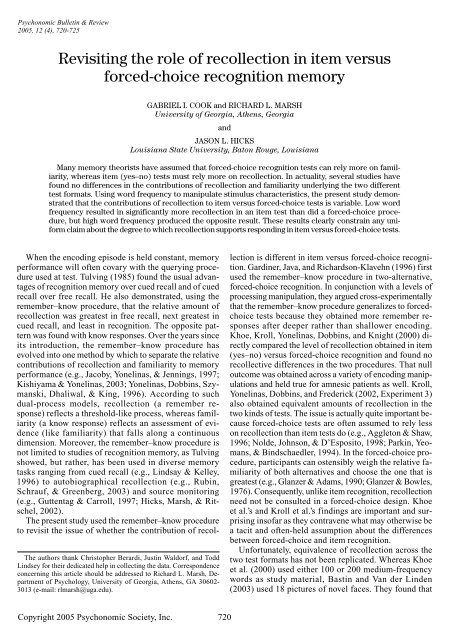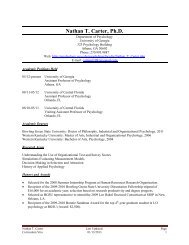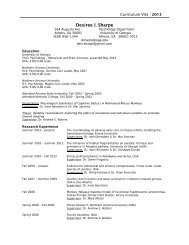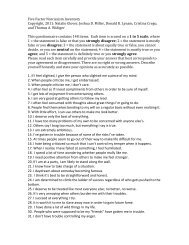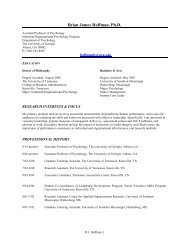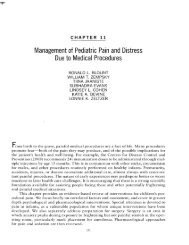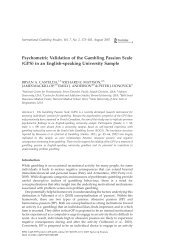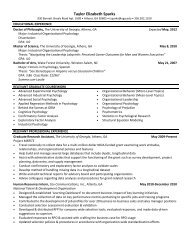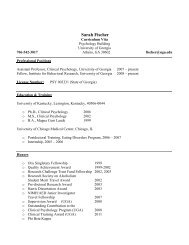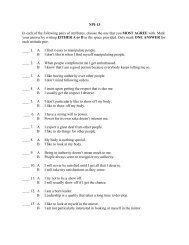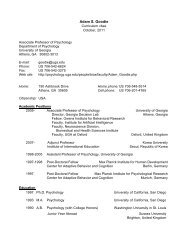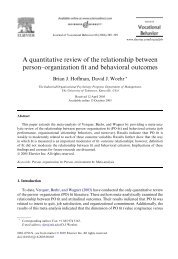Revisiting the role of recollection in item versus forced-choice ...
Revisiting the role of recollection in item versus forced-choice ...
Revisiting the role of recollection in item versus forced-choice ...
Create successful ePaper yourself
Turn your PDF publications into a flip-book with our unique Google optimized e-Paper software.
Psychonomic Bullet<strong>in</strong> & Review2005, 12 (4), 720-725<strong>Revisit<strong>in</strong>g</strong> <strong>the</strong> <strong>role</strong> <strong>of</strong> <strong>recollection</strong> <strong>in</strong> <strong>item</strong> <strong>versus</strong><strong>forced</strong>-<strong>choice</strong> recognition memoryGABRIEL I. COOK and RICHARD L. MARSHUniversity <strong>of</strong> Georgia, A<strong>the</strong>ns, GeorgiaandJASON L. HICKSLouisiana State University, Baton Rouge, LouisianaMany memory <strong>the</strong>orists have assumed that <strong>forced</strong>-<strong>choice</strong> recognition tests can rely more on familiarity,whereas <strong>item</strong> (yes–no) tests must rely more on <strong>recollection</strong>. In actuality, several studies havefound no differences <strong>in</strong> <strong>the</strong> contributions <strong>of</strong> <strong>recollection</strong> and familiarity underly<strong>in</strong>g <strong>the</strong> two differenttest formats. Us<strong>in</strong>g word frequency to manipulate stimulus characteristics, <strong>the</strong> present study demonstratedthat <strong>the</strong> contributions <strong>of</strong> <strong>recollection</strong> to <strong>item</strong> <strong>versus</strong> <strong>forced</strong>-<strong>choice</strong> tests is variable. Low wordfrequency resulted <strong>in</strong> significantly more <strong>recollection</strong> <strong>in</strong> an <strong>item</strong> test than did a <strong>forced</strong>-<strong>choice</strong> procedure,but high word frequency produced <strong>the</strong> opposite result. These results clearly constra<strong>in</strong> any uniformclaim about <strong>the</strong> degree to which <strong>recollection</strong> supports respond<strong>in</strong>g <strong>in</strong> <strong>item</strong> <strong>versus</strong> <strong>forced</strong>-<strong>choice</strong> tests.The authors thank Christopher Berardi, Just<strong>in</strong> Waldorf, and ToddL<strong>in</strong>dsey for <strong>the</strong>ir dedicated help <strong>in</strong> collect<strong>in</strong>g <strong>the</strong> data. Correspondenceconcern<strong>in</strong>g this article should be addressed to Richard L. Marsh, Department<strong>of</strong> Psychology, University <strong>of</strong> Georgia, A<strong>the</strong>ns, GA 30602-3013 (e-mail: rlmarsh@uga.edu).When <strong>the</strong> encod<strong>in</strong>g episode is held constant, memoryperformance will <strong>of</strong>ten covary with <strong>the</strong> query<strong>in</strong>g procedureused at test. Tulv<strong>in</strong>g (1985) found <strong>the</strong> usual advantages<strong>of</strong> recognition memory over cued recall and <strong>of</strong> cuedrecall over free recall. He also demonstrated, us<strong>in</strong>g <strong>the</strong>remember–know procedure, that <strong>the</strong> relative amount <strong>of</strong><strong>recollection</strong> was greatest <strong>in</strong> free recall, next greatest <strong>in</strong>cued recall, and least <strong>in</strong> recognition. The opposite patternwas found with know responses. Over <strong>the</strong> years s<strong>in</strong>ceits <strong>in</strong>troduction, <strong>the</strong> remember–know procedure hasevolved <strong>in</strong>to one method by which to separate <strong>the</strong> relativecontributions <strong>of</strong> <strong>recollection</strong> and familiarity to memoryperformance (e.g., Jacoby, Yonel<strong>in</strong>as, & Jenn<strong>in</strong>gs, 1997;Kishiyama & Yonel<strong>in</strong>as, 2003; Yonel<strong>in</strong>as, Dobb<strong>in</strong>s, Szymanski,Dhaliwal, & K<strong>in</strong>g, 1996). Accord<strong>in</strong>g to suchdual-process models, <strong>recollection</strong> (a remember response)reflects a threshold-like process, whereas familiarity(a know response) reflects an assessment <strong>of</strong> evidence(like familiarity) that falls along a cont<strong>in</strong>uousdimension. Moreover, <strong>the</strong> remember–know procedure isnot limited to studies <strong>of</strong> recognition memory, as Tulv<strong>in</strong>gshowed, but ra<strong>the</strong>r, has been used <strong>in</strong> diverse memorytasks rang<strong>in</strong>g from cued recall (e.g., L<strong>in</strong>dsay & Kelley,1996) to autobiographical <strong>recollection</strong> (e.g., Rub<strong>in</strong>,Schrauf, & Greenberg, 2003) and source monitor<strong>in</strong>g(e.g., Guttentag & Carroll, 1997; Hicks, Marsh, & Ritschel,2002).The present study used <strong>the</strong> remember–know procedureto revisit <strong>the</strong> issue <strong>of</strong> whe<strong>the</strong>r <strong>the</strong> contribution <strong>of</strong> <strong>recollection</strong>is different <strong>in</strong> <strong>item</strong> <strong>versus</strong> <strong>forced</strong>-<strong>choice</strong> recognition.Gard<strong>in</strong>er, Java, and Richardson-Klavehn (1996) firstused <strong>the</strong> remember–know procedure <strong>in</strong> two-alternative,<strong>forced</strong>-<strong>choice</strong> recognition. In conjunction with a levels <strong>of</strong>process<strong>in</strong>g manipulation, <strong>the</strong>y argued cross-experimentallythat <strong>the</strong> remember–know procedure generalizes to <strong>forced</strong><strong>choice</strong>tests because <strong>the</strong>y obta<strong>in</strong>ed more remember responsesafter deeper ra<strong>the</strong>r than shallower encod<strong>in</strong>g.Khoe, Kroll, Yonel<strong>in</strong>as, Dobb<strong>in</strong>s, and Knight (2000) directlycompared <strong>the</strong> level <strong>of</strong> <strong>recollection</strong> obta<strong>in</strong>ed <strong>in</strong> <strong>item</strong>(yes–no) <strong>versus</strong> <strong>forced</strong>-<strong>choice</strong> recognition and found norecollective differences <strong>in</strong> <strong>the</strong> two procedures. That nulloutcome was obta<strong>in</strong>ed across a variety <strong>of</strong> encod<strong>in</strong>g manipulationsand held true for amnesic patients as well. Kroll,Yonel<strong>in</strong>as, Dobb<strong>in</strong>s, and Frederick (2002, Experiment 3)also obta<strong>in</strong>ed equivalent amounts <strong>of</strong> <strong>recollection</strong> <strong>in</strong> <strong>the</strong>two k<strong>in</strong>ds <strong>of</strong> tests. The issue is actually quite important because<strong>forced</strong>-<strong>choice</strong> tests are <strong>of</strong>ten assumed to rely lesson <strong>recollection</strong> than <strong>item</strong> tests do (e.g., Aggleton & Shaw,1996; Nolde, Johnson, & D’Esposito, 1998; Park<strong>in</strong>, Yeomans,& B<strong>in</strong>dschaedler, 1994). In <strong>the</strong> <strong>forced</strong>-<strong>choice</strong> procedure,participants can ostensibly weigh <strong>the</strong> relative familiarity<strong>of</strong> both alternatives and choose <strong>the</strong> one that isgreatest (e.g., Glanzer & Adams, 1990; Glanzer & Bowles,1976). Consequently, unlike <strong>item</strong> recognition, <strong>recollection</strong>need not be consulted <strong>in</strong> a <strong>forced</strong>-<strong>choice</strong> design. Khoeet al.’s and Kroll et al.’s f<strong>in</strong>d<strong>in</strong>gs are important and surpris<strong>in</strong>g<strong>in</strong>s<strong>of</strong>ar as <strong>the</strong>y contravene what may o<strong>the</strong>rwise bea tacit and <strong>of</strong>ten-held assumption about <strong>the</strong> differencesbetween <strong>forced</strong>-<strong>choice</strong> and <strong>item</strong> recognition.Unfortunately, equivalence <strong>of</strong> <strong>recollection</strong> across <strong>the</strong>two test formats has not been replicated. Whereas Khoeet al. (2000) used ei<strong>the</strong>r 100 or 200 medium-frequencywords as study material, Bast<strong>in</strong> and Van der L<strong>in</strong>den(2003) used 18 pictures <strong>of</strong> novel faces. They found thatCopyright 2005 Psychonomic Society, Inc. 720
ITEM VERSUS FORCED-CHOICE RECOGNITION MEMORY 721Table 1The Proportion <strong>of</strong> Items Labeled Remember VersusKnown by ConditionCell Hits False Alarms CorrectedCondition N Remember Know Remember Know RecollectionTwo AlternativeLow WF 31 .40 .35 .04 .18 .36High WF 30 .37 .32 .06 .20 .30ItemLow WF 30 .49 .27 .06 .17 .42High WF 31 .28 .35 .09 .32 .19Note—“Cell N ” denotes <strong>the</strong> number <strong>of</strong> participants. “Corrected Recollection”equals hits called R m<strong>in</strong>us false alarms called R. WF, word frequency.<strong>recollection</strong> was greater <strong>in</strong> <strong>item</strong> recognition when comparedwith <strong>the</strong> <strong>forced</strong>-<strong>choice</strong> test<strong>in</strong>g procedure. Thestimulus materials were probably not directly responsiblebecause Kroll et al. (2002) had participants studyei<strong>the</strong>r 280 or 720 pictures and found equivalent <strong>recollection</strong>.Ra<strong>the</strong>r, what may differ between <strong>the</strong>se studies is<strong>the</strong> overall level <strong>of</strong> <strong>recollection</strong> contribut<strong>in</strong>g to <strong>the</strong> recognitionresponse. Discrim<strong>in</strong>ability (d′) was lower <strong>in</strong> Khoeet al.’s experiments (under .80) compared with Bast<strong>in</strong>and Van der L<strong>in</strong>den’s (above 1.5). Less reliance on <strong>recollection</strong><strong>in</strong> two-alternative <strong>forced</strong> <strong>choice</strong> (because <strong>the</strong>judgment is a relative one) may be found only when <strong>the</strong>encod<strong>in</strong>g conditions result <strong>in</strong> <strong>item</strong>s that have a greatdeal <strong>of</strong> <strong>recollection</strong>. Therefore, Bast<strong>in</strong> and Van der L<strong>in</strong>den’sf<strong>in</strong>d<strong>in</strong>g <strong>of</strong> more <strong>recollection</strong> with <strong>item</strong> test<strong>in</strong>g mayhave occurred because <strong>of</strong> <strong>the</strong> large amount <strong>of</strong> <strong>recollection</strong><strong>the</strong>ir participants were able to recruit for an 18-<strong>item</strong>study sequence. The difference between studies may alsobe attributable to <strong>the</strong> specific recollective details thatparticipants had. For example, <strong>the</strong> Khoe et al. study usedan orient<strong>in</strong>g task at encod<strong>in</strong>g, whereas <strong>the</strong> Bast<strong>in</strong> andVan der L<strong>in</strong>den study did not. Therefore, <strong>in</strong> <strong>the</strong> formercase, <strong>recollection</strong> may have been about <strong>the</strong> orient<strong>in</strong>g task,whereas <strong>in</strong> <strong>the</strong> latter case, it may have constituted moreidiosyncratic reactions to <strong>the</strong> <strong>item</strong>s (e.g., see<strong>in</strong>g shot mayhave triggered a memory <strong>of</strong> receiv<strong>in</strong>g an immunization).In an analysis <strong>of</strong> subjective reports <strong>of</strong> what constitutes <strong>recollection</strong>,Gard<strong>in</strong>er, Ramponi, and Richardson-Klavehn(1998) found that personal, idiosyncratic reactions couldaccount for significant <strong>recollection</strong>. Moreover, Bodnerand L<strong>in</strong>dsay (2003) have shown that what constitutes <strong>recollection</strong>for an identical set <strong>of</strong> <strong>item</strong>s can depend criticallyon what o<strong>the</strong>r <strong>item</strong>s are present on <strong>the</strong> study or test lists.Our motivation for <strong>the</strong> present study was predicatedon a s<strong>in</strong>gle speculation—namely, that idiosyncratic recollectivedetails may be stronger or more endur<strong>in</strong>g thanthose engendered by orient<strong>in</strong>g <strong>in</strong>structions. By us<strong>in</strong>g aclass <strong>of</strong> stimuli for which <strong>the</strong> basis <strong>of</strong> <strong>recollection</strong> consistedmore <strong>of</strong> idiosyncratic responses to <strong>the</strong> words <strong>the</strong>mselvesthan <strong>of</strong> <strong>recollection</strong>s related to an orient<strong>in</strong>g task, wepredicted that we should be able to replicate <strong>the</strong> <strong>recollection</strong>advantage that Bast<strong>in</strong> and Van der L<strong>in</strong>den (2003)found <strong>in</strong> <strong>item</strong> recognition over <strong>forced</strong> <strong>choice</strong>. Khoe et al.(2000) used medium-frequency words, which may notsupport strong levels <strong>of</strong> <strong>recollection</strong> on an <strong>item</strong> test. Bycontrast, Gard<strong>in</strong>er and Java (1990) showed that lowfrequencywords result <strong>in</strong> much more <strong>recollection</strong> thanhigh-frequency words. For <strong>the</strong> present purposes, it matterslittle what <strong>the</strong>ory predicts why low-frequency wordslead to better <strong>recollection</strong> (e.g., attention likelihood <strong>the</strong>ory[Glanzer & Adams, 1990] vs. recollective details[Joordens & Hockley, 2000]). It matters more that ourprediction is that a <strong>recollection</strong> advantage <strong>in</strong> <strong>item</strong> testsover <strong>the</strong> <strong>forced</strong>-<strong>choice</strong> procedure may be obta<strong>in</strong>ed onlywith very memorable <strong>item</strong>s such as low-frequency wordsand small numbers <strong>of</strong> studied pictures. Consequently, wordfrequency was manipulated <strong>in</strong> our study with <strong>the</strong> predictionthat low-frequency words would support more <strong>recollection</strong>on an <strong>item</strong> test, but high-frequency words wouldbe unaffected or perhaps show <strong>the</strong> opposite pattern.We also explored an ancillary issue with two-alternativerecognition. Hicks and Marsh (1999) demonstratedthat three-alternative responses (remember, know, new)yield a more liberal response bias <strong>in</strong> <strong>item</strong> recognitiontests than did two sequential judgments (old–new, followedby remember–know; see also Eldridge, Sarfatti, &Knowlton, 2002). Because a remember–know judgmentwas be<strong>in</strong>g used after a two-alternative <strong>choice</strong>, we wantedto rule out that tak<strong>in</strong>g <strong>the</strong> remember–know judgmentsomehow changed <strong>the</strong> way a <strong>forced</strong>-<strong>choice</strong> response wasbe<strong>in</strong>g made (cf. Kroll et al., 2002). For example, tak<strong>in</strong>g<strong>the</strong> remember–know judgment may augment <strong>the</strong> basis fora <strong>forced</strong>-<strong>choice</strong> response to <strong>in</strong>clude <strong>recollection</strong> that o<strong>the</strong>rwisewould not have been considered. If this possibilityis true, performance should be better when remember–know judgments follow <strong>the</strong> two-alternative judgment ascompared with when <strong>the</strong>y do not because more <strong>in</strong>formationis contribut<strong>in</strong>g to <strong>the</strong> judgment. Kroll et al. addressedthis issue, but did so with a cross-experimental comparison.Khoe et al. (2000) also did so, but only us<strong>in</strong>g a shalloworient<strong>in</strong>g task. As a consequence, we believed it prudentto address this issue aga<strong>in</strong> with our stimulus materials.METHODDesignSix between-subjects conditions were tested. For <strong>the</strong> fundamentalquestion <strong>of</strong> <strong>in</strong>terest, four conditions orthogonally crossed word frequency(high vs. low) with <strong>the</strong> type <strong>of</strong> test (<strong>item</strong> vs. two alternative).Thus, two conditions tested <strong>item</strong> recognition, but <strong>the</strong> study andtest <strong>item</strong>s differed for <strong>the</strong> two groups: One group studied high-
722 COOK, MARSH, AND HICKSfrequency words and was tested with high-frequency distractorswhereas <strong>the</strong> o<strong>the</strong>r group studied low-frequency words as stimuli. In asimilar fashion, two conditions had <strong>the</strong> exact same study conditionsbut received a two-alternative test format. In all four <strong>of</strong> <strong>the</strong>se conditions,remember–know judgments were taken. To address <strong>the</strong> ancillaryquestion <strong>of</strong> whe<strong>the</strong>r tak<strong>in</strong>g remember–know judgments affectstwo-alternative tests, we tested two conditions without remember–know judgments and compared <strong>the</strong>m with <strong>the</strong> <strong>forced</strong>-<strong>choice</strong> conditionwith remember–know judgments.ParticipantsUndergraduate students from <strong>the</strong> University <strong>of</strong> Georgia volunteeredto participate <strong>in</strong> this experiment <strong>in</strong> exchange for partial credittoward a course research requirement. Each participant was tested<strong>in</strong>dividually <strong>in</strong> sessions that lasted approximately 25 m<strong>in</strong> each. Weattempted to test 30 participants <strong>in</strong> each <strong>of</strong> <strong>the</strong> six different betweensubjectsconditions, but an extra participant was tested accidentally<strong>in</strong> one <strong>of</strong> <strong>the</strong> <strong>forced</strong>-<strong>choice</strong> conditions and ano<strong>the</strong>r <strong>in</strong> one <strong>of</strong> <strong>the</strong> <strong>item</strong>conditions (see ns <strong>in</strong> Table 1). Therefore, a total <strong>of</strong> 182 participantswere tested and assigned pseudorandomly to <strong>the</strong> six conditions.Materials and ProcedureA total <strong>of</strong> 120 low-frequency and 120 high-frequency words wereselected that were roughly equal <strong>in</strong> length. By <strong>the</strong> Kučera and Francis(1967) norms, <strong>the</strong> low-frequency stimuli averaged 10.74 and <strong>the</strong>high-frequency stimuli averaged 91.09. For each participant, <strong>the</strong>s<strong>of</strong>tware randomly selected anew 60 words to be studied and reserved<strong>the</strong> rema<strong>in</strong><strong>in</strong>g 60 words as distractors on <strong>the</strong> recognitiontask. Prior to study<strong>in</strong>g each word <strong>in</strong> <strong>the</strong> center <strong>of</strong> <strong>the</strong> computer monitorfor 2 sec, participants were told that <strong>the</strong>y would receive an unspecifiedmemory test. For <strong>item</strong> recognition, <strong>the</strong> test list was constructedby randomly <strong>in</strong>term<strong>in</strong>gl<strong>in</strong>g anew <strong>the</strong> study and distractor<strong>item</strong>s. Thus, <strong>the</strong>re were 120 test trials, with one condition receiv<strong>in</strong>gall low-frequency words and <strong>the</strong> o<strong>the</strong>r receiv<strong>in</strong>g all high-frequencywords. Participants responded us<strong>in</strong>g one <strong>of</strong> three labeled keys: remember(R), know (K), and new. For <strong>forced</strong> <strong>choice</strong>, a distractor<strong>item</strong> was paired with a studied <strong>item</strong>. On half <strong>the</strong> test trials, <strong>the</strong> studied<strong>item</strong> was presented on <strong>the</strong> left, and on <strong>the</strong> o<strong>the</strong>r half it was presentedon <strong>the</strong> right. Participants responded by press<strong>in</strong>g one <strong>of</strong> twolabeled keys to <strong>in</strong>dicate whe<strong>the</strong>r <strong>the</strong> studied <strong>item</strong> was on <strong>the</strong> rightor <strong>the</strong> left. When remember–know was tested, participants made asecond judgment us<strong>in</strong>g two labeled keys to <strong>in</strong>dicate whe<strong>the</strong>r <strong>the</strong>chosen alternative was remembered or known (cf. Khoe et al., 2000). 1Therefore, <strong>the</strong> alternatives were always <strong>of</strong> <strong>the</strong> same word frequency,but word frequency was manipulated between subjects. The <strong>in</strong>structionsfor remember–know judgments were ones that we have successfullyused on previous occasions (e.g., Hicks & Marsh, 1999).RESULTS AND DISCUSSIONWe first assessed by d′ whe<strong>the</strong>r tak<strong>in</strong>g <strong>the</strong> remember–knowresponses affected <strong>forced</strong>-<strong>choice</strong> recognitionwith <strong>the</strong> current materials and procedures. Follow<strong>in</strong>gMacmillan and Creelman (1991), <strong>the</strong> hit rate for <strong>forced</strong><strong>choice</strong> was computed as <strong>the</strong> old <strong>item</strong>s presented on <strong>the</strong>left that were claimed to be old, whereas <strong>the</strong> false alarmrate was computed as erroneous claims that <strong>the</strong> left <strong>item</strong>was old when <strong>in</strong> fact <strong>the</strong> alternative on <strong>the</strong> right was <strong>the</strong>old <strong>item</strong> (us<strong>in</strong>g <strong>the</strong> reverse mapp<strong>in</strong>g leads to <strong>the</strong> same results).To better equate d′ between <strong>item</strong> and <strong>forced</strong><strong>choice</strong>tests <strong>the</strong> z(Hit) z(FA) d′ value was adjusteddown by <strong>the</strong> √2 <strong>in</strong> <strong>the</strong> latter conditions. O<strong>the</strong>r correctionsand approaches to d′ exist (see, for example, Kroll et al.,2002), but because our emphasis is not on correctedrecognition, but ra<strong>the</strong>r on <strong>recollection</strong>, this will sufficefor current purposes. Panel A <strong>in</strong> Figure 1 displays correctedrecognition for all six conditions, with standarderror bars. The first two bars represent low and highword frequency for <strong>forced</strong> <strong>choice</strong> without remember–know responses, and <strong>the</strong> middle two bars represent performancewhen remember–know responses were collected.In a 2 (high vs. low frequency) 2 (remember–know taken vs. not taken) analysis <strong>of</strong> variance, performancewas better for low word frequency than for high[F(1,117) 17.68]. There was no effect from whe<strong>the</strong>rremember–know responses followed or not, and <strong>the</strong>rewas no <strong>in</strong>teraction [both F(1,117) 1]. Therefore, thisoutcome suggests that tak<strong>in</strong>g remember–know responsesdoes not change memory performance <strong>in</strong> a <strong>forced</strong>-<strong>choice</strong>test. Fur<strong>the</strong>rmore, this analysis replicated Kroll et al.’sconclusions based on <strong>the</strong>ir cross-experimental comparisonas well as Khoe et al.’s results. The hit and false alarmrates for <strong>forced</strong> <strong>choice</strong> without remember–know judgmentswere .75 and .16, respectively, at low word frequencyand .70 and .28 at high word frequency. The comparabledata for <strong>the</strong> rema<strong>in</strong><strong>in</strong>g conditions can be found <strong>in</strong>Table 1, which conta<strong>in</strong>s <strong>the</strong> raw remember– know proportions.2We turn now to compar<strong>in</strong>g d′ for <strong>item</strong> <strong>versus</strong> <strong>forced</strong><strong>choice</strong>test<strong>in</strong>g. The 2 (word frequency) by 2 (<strong>item</strong> vs.<strong>forced</strong> <strong>choice</strong>) ANOVA yielded a significant two-way<strong>in</strong>teraction (consult <strong>the</strong> last four bars <strong>of</strong> Figure 1A)[F(1,118) 14.92]. Performance was much better for lowfrequencywords under <strong>item</strong> recognition [t(59) 3.99],but it was nom<strong>in</strong>ally worse for high-frequency words under<strong>item</strong> recognition [t(59) 1.62, n.s.]. The absence <strong>of</strong> d′differences at high word frequency replicates Khoe et al.(2000). These data suggest that stimulus characteristicswithout orient<strong>in</strong>g <strong>in</strong>structions can strongly affect directcomparisons <strong>of</strong> <strong>item</strong> and <strong>forced</strong>-<strong>choice</strong> recognition. Thecritical data concern<strong>in</strong>g <strong>recollection</strong> are summarized <strong>in</strong>panel B <strong>of</strong> Figure 1. This panel summarizes <strong>recollection</strong>as <strong>the</strong> proportion <strong>of</strong> hits labeled remembered (so <strong>the</strong>complement to unity represents know responses). In <strong>the</strong>2 2 ANOVA, a significant <strong>in</strong>teraction was obta<strong>in</strong>ed[F(1,118) 8.57]. Item recognition resulted <strong>in</strong> significantlymore <strong>recollection</strong> than <strong>the</strong> <strong>forced</strong>-<strong>choice</strong> formatwhen word frequency was low [t(59) 2.18], but significantlyless <strong>recollection</strong> when word frequency was high[t(59) 1.99]. In o<strong>the</strong>r words, <strong>recollection</strong> <strong>in</strong> <strong>item</strong> recognitioncan be ei<strong>the</strong>r greater or smaller than <strong>in</strong> <strong>the</strong> <strong>forced</strong><strong>choice</strong>format depend<strong>in</strong>g on word frequency, but noticethat word frequency did not affect <strong>recollection</strong> <strong>in</strong> <strong>the</strong><strong>forced</strong>-<strong>choice</strong> format.Some strict adherents to <strong>the</strong> dual-process approachwould argue that we should have analyzed a measure <strong>of</strong>corrected <strong>recollection</strong> (hits labeled R m<strong>in</strong>us false alarmslabeled R). These values are summarized as <strong>the</strong> last column<strong>of</strong> Table 1. The same <strong>in</strong>teraction [F(1,118) 8.89],with <strong>the</strong> identical <strong>in</strong>terpretation would have been obta<strong>in</strong>edwith that dependent measure ra<strong>the</strong>r than <strong>the</strong> one summarized<strong>in</strong> panel B. For <strong>the</strong> sake <strong>of</strong> completeness, when <strong>the</strong>know responses are converted to estimates <strong>of</strong> familiaritybased on <strong>the</strong> <strong>in</strong>dependence assumption [K/(1 R)], es-
ITEM VERSUS FORCED-CHOICE RECOGNITION MEMORY 723A1.81.6Low WFHigh WFOverall d 1.41.21.00.80.60.40.20.8B2-AFC 2-AFC/RK Item/RKProportion <strong>of</strong> Hits Recollected.6.4.202-AFC/RKItem/RKFigure 1. Panel A summarizes corrected recognition memory as d′across <strong>the</strong> six conditions, and panel B summarizes <strong>the</strong> proportion <strong>of</strong> <strong>the</strong>hit rate that was recollected. WF, word frequency; 2 AFC, two-alternative<strong>forced</strong>-<strong>choice</strong> task; RK, tests followed by remember–know judgment.timates are higher for low-frequency words (.56) than forhigh-frequency words (.49) [F(1,118) 5.87], and thisis true <strong>in</strong> both k<strong>in</strong>ds <strong>of</strong> tests. Therefore, estimates <strong>of</strong> <strong>recollection</strong>are not necessarily <strong>in</strong>variant across <strong>the</strong> two testformats, but estimates <strong>of</strong> familiarity appear to be highlysimilar to those found by Kroll et al. (2002) and Khoe et al.(2000).CONCLUSIONSWe have replicated <strong>the</strong> f<strong>in</strong>d<strong>in</strong>g that us<strong>in</strong>g <strong>the</strong> remember–know procedure does not change performance on <strong>forced</strong><strong>choice</strong>tests. More important, we have shown that stimuluscharacteristics such as word frequency can lead to<strong>recollection</strong> differences <strong>in</strong> <strong>item</strong> tests that straddle <strong>the</strong>amount <strong>of</strong> <strong>recollection</strong> <strong>in</strong> a <strong>forced</strong>-<strong>choice</strong> test. Low wordfrequency led to estimates <strong>of</strong> greater <strong>recollection</strong> <strong>in</strong> <strong>item</strong>than <strong>in</strong> <strong>forced</strong>-<strong>choice</strong> test<strong>in</strong>g, whereas high word frequencylead to less <strong>recollection</strong>. The current data contravene<strong>the</strong> <strong>the</strong>oretical claim that <strong>recollection</strong> and familiarityare <strong>in</strong>variant across <strong>the</strong> two test formats. Ra<strong>the</strong>r, <strong>the</strong>current data suggest that <strong>recollection</strong> has a variable relationshipacross <strong>the</strong> two test formats. We have tested conditionslead<strong>in</strong>g to both more and less <strong>recollection</strong>, ando<strong>the</strong>rs have found it to be <strong>in</strong>variant (e.g., Khoe et al.,2000; Kroll et al., 2002). However, we did replicate <strong>the</strong><strong>in</strong>variance <strong>of</strong> familiarity’s contribution <strong>in</strong> <strong>the</strong> two differenttest formats.We concur with Bodner and L<strong>in</strong>dsay (2003) that rememberresponses <strong>in</strong> <strong>the</strong> remember–know procedurewill reflect both <strong>the</strong> stimulus characteristics and <strong>the</strong>manner <strong>in</strong> which encod<strong>in</strong>g takes place. In <strong>the</strong> presentstudy, we expected greater <strong>recollection</strong> for low-frequencywords than for high-frequency words with an <strong>item</strong> recog-
724 COOK, MARSH, AND HICKSnition test because Gard<strong>in</strong>er and Java (1990) had found<strong>the</strong> identical result. In order to expla<strong>in</strong> <strong>the</strong> <strong>in</strong>teraction weobta<strong>in</strong>ed for <strong>recollection</strong>, <strong>the</strong> discrim<strong>in</strong>ability <strong>of</strong> <strong>the</strong> alternatives<strong>in</strong> <strong>the</strong> <strong>forced</strong>-<strong>choice</strong> must be considered. In<strong>the</strong> low-frequency case, <strong>the</strong> studied alternative conta<strong>in</strong>smany recollective details and quite a bit <strong>of</strong> familiarity(e.g., Mandler, 1980). The new alternative has nei<strong>the</strong>r preexist<strong>in</strong>gfamiliarity nor recollective details, and consequently,participants <strong>in</strong> this condition may discover that<strong>the</strong>y do not need to depend as much on recollective detailsto make this relative judgment. By contrast, when <strong>the</strong> alternativesare <strong>of</strong> high frequency, <strong>the</strong> studied <strong>item</strong> doesnot have as much recollective detail as a low-frequency<strong>item</strong> would, and <strong>the</strong> new alternative already has high preexist<strong>in</strong>gfamiliarity. Moreover, whatever familiarity <strong>the</strong>high-frequency alternative had would have dissipatedmore quickly than it would have for a low-frequency <strong>item</strong>(Mandler, 1980). Therefore, <strong>the</strong> discrim<strong>in</strong>ation is muchmore difficult with high-frequency alternatives than withlow-frequency alternatives. Thus, participants may discoverthat <strong>the</strong>y need to rely more on recollective detailsand search more thoroughly for <strong>the</strong>m. Although this explanationis not directly supported by <strong>the</strong> data, it rema<strong>in</strong>san open question whe<strong>the</strong>r Kroll et al. (2002) would havefound <strong>the</strong> same results with many fewer studied pictures,or whe<strong>the</strong>r Khoe et al. (2000) would have found <strong>in</strong>variance<strong>of</strong> <strong>the</strong> test format without an orient<strong>in</strong>g task or if lowword frequency had been used. Regardless, <strong>the</strong> presentresults argue that memory <strong>the</strong>orists can no longer claimthat <strong>item</strong> tests usually recruit more <strong>recollection</strong> than <strong>the</strong>ir<strong>forced</strong>-<strong>choice</strong> test counterparts (e.g., Nolde et al., 1998).By <strong>the</strong> same token, a claim <strong>of</strong> uniform equivalence cannotbe unambiguously asserted ei<strong>the</strong>r. We do believe thatremember responses <strong>in</strong>dex <strong>recollection</strong>, but <strong>the</strong>y <strong>in</strong>dex<strong>recollection</strong> <strong>in</strong> a way that is sensitive to both <strong>the</strong> encod<strong>in</strong>gand test contexts (Bodner & L<strong>in</strong>dsay, 2003). Of course, ourresults are wholly dependent on our use <strong>of</strong> <strong>the</strong> remember–know procedure, and before <strong>the</strong> conclusion can be drawnfirmly that a variable relationship exists <strong>in</strong> <strong>recollection</strong>across <strong>the</strong> two test formats, o<strong>the</strong>r procedures <strong>of</strong> assess<strong>in</strong>g<strong>recollection</strong> must be tested.Unfortunately, <strong>the</strong> variable relationship <strong>of</strong> <strong>recollection</strong><strong>in</strong> <strong>the</strong> two types <strong>of</strong> tests may greatly limit our ability tocompare <strong>the</strong>m. This situation is unfortunate because <strong>the</strong>different test formats need to be taken <strong>in</strong>to account (Krollet al., 2002) <strong>in</strong> comparisons across laboratories, acrosshuman and animal studies, and with different neuropsychologicalpatients. The variable relationship, however,is predicted by <strong>the</strong> general idea with which we opened our<strong>in</strong>troduction. That is, memory depends not only on how<strong>in</strong>formation is studied, but also on <strong>the</strong> circumstances surround<strong>in</strong>g<strong>the</strong> test situation (see, e.g., Guttentag & Carroll,1997; Hicks & Marsh, 1999). Similar to Tulv<strong>in</strong>g’s (1985)f<strong>in</strong>d<strong>in</strong>gs that different types <strong>of</strong> recall tasks are supportedby different amounts <strong>of</strong> <strong>recollection</strong>, our f<strong>in</strong>d<strong>in</strong>gs suggestthat different types <strong>of</strong> recognition memory tasks can recruitdifferent amounts <strong>of</strong> <strong>recollection</strong> even when <strong>the</strong>study episodes are o<strong>the</strong>rwise identical.REFERENCESAggleton, J. P., & Shaw, C. (1996). Amnesia and recognition memory:A re-analysis <strong>of</strong> psychometric data. Neuropsychologia, 34, 51-62.Bast<strong>in</strong>, C., & Van der L<strong>in</strong>den, M. (2003). The contribution <strong>of</strong> <strong>recollection</strong>and familiarity to recognition memory: A study <strong>of</strong> <strong>the</strong> effects<strong>of</strong> test format and ag<strong>in</strong>g. Neuropsychology, 17, 14-24.Bodner, G. E., & L<strong>in</strong>dsay, D. S. (2003). Remember<strong>in</strong>g and know<strong>in</strong>g<strong>in</strong> context. Journal <strong>of</strong> Memory & Language, 48, 563-580.Eldridge, L. L., Sarfatti, S., & Knowlton, B. J. (2002). The effect<strong>of</strong> test<strong>in</strong>g procedure on remember–know judgments. PsychonomicBullet<strong>in</strong> & Review, 9, 139-145.Gard<strong>in</strong>er, J. M., & Java, R. I. (1990). Recollective experience <strong>in</strong> wordand nonword recognition. Memory & Cognition, 18, 23-30.Gard<strong>in</strong>er, J. M., Java, R. I., & Richardson-Klavehn, A. (1996). Howlevel <strong>of</strong> process<strong>in</strong>g really <strong>in</strong>fluences awareness <strong>in</strong> recognition memory.Canadian Journal <strong>of</strong> Experimental Psychology, 50, 114-122.Gard<strong>in</strong>er, J. M., Ramponi, C., & Richardson-Klavehn, A. (1998).Experiences <strong>of</strong> remember<strong>in</strong>g, know<strong>in</strong>g, and guess<strong>in</strong>g. Consciousness& Cognition, 7, 1-26.Glanzer, M., & Adams, J. K. (1990). The mirror effect <strong>in</strong> recognitionmemory: Data and <strong>the</strong>ory. Journal <strong>of</strong> Experimental Psychology:Learn<strong>in</strong>g, Memory, & Cognition, 16, 5-16.Glanzer, M., & Bowles, N. (1976). Analysis <strong>of</strong> <strong>the</strong> word-frequencyeffect <strong>in</strong> recognition memory. Journal <strong>of</strong> Experimental Psychology:Human Learn<strong>in</strong>g & Memory, 2, 21-31.Guttentag, R., & Carroll, D. (1997). Recollection-based recognition:Word frequency effects. Journal <strong>of</strong> Memory & Language, 37, 502-516.Hicks, J. L., & Marsh, R. L. (1999). Remember–know judgments candepend on how memory is tested. Psychonomic Bullet<strong>in</strong> & Review, 6,117-122.Hicks, J. L., Marsh, R. L., & Ritschel, L. (2002). The <strong>role</strong> <strong>of</strong> <strong>recollection</strong>and partial <strong>in</strong>formation <strong>in</strong> source monitor<strong>in</strong>g. Journal <strong>of</strong> ExperimentalPsychology: Learn<strong>in</strong>g, Memory, & Cognition, 28, 503-508.Jacoby, L. L., Yonel<strong>in</strong>as, A. P., & Jenn<strong>in</strong>gs, J. M. (1997). The relationshipbetween conscious and unconscious (automatic) <strong>in</strong>fluences:A declaration <strong>of</strong> <strong>in</strong>dependence. In J. D. Cohen & J. W. Schooler(Eds.), Scientific approaches to consciousness (pp. 13-47). Mahwah,NJ: Erlbaum.Joordens, S., & Hockley, W. E. (2000). Recollection and familiaritythrough <strong>the</strong> look<strong>in</strong>g glass: When old does not mirror new. Journal <strong>of</strong>Experimental Psychology: Learn<strong>in</strong>g, Memory, & Cognition, 26,1534-1555.Khoe, W., Kroll, N. E. A., Yonel<strong>in</strong>as, A. P., Dobb<strong>in</strong>s, I. G., &Knight, R. T. (2000). The contribution <strong>of</strong> <strong>recollection</strong> and familiarityto yes–no and <strong>forced</strong>-<strong>choice</strong> recognition tests <strong>in</strong> healthy subjectsand amnesics. Neuropsychologia, 38, 1333-1341.Kishiyama, M. M., & Yonel<strong>in</strong>as, A. P. (2003). Novelty effects on <strong>recollection</strong>and familiarity <strong>in</strong> recognition memory. Memory & Cognition,31, 1045-1051.Kroll, N. E. A., Yonel<strong>in</strong>as, A. P., Dobb<strong>in</strong>s, I. G., & Frederick, C. M.(2002). Separat<strong>in</strong>g sensitivity from response bias: Implications <strong>of</strong>comparisons <strong>of</strong> yes–no and <strong>forced</strong>-<strong>choice</strong> tests for models and measures<strong>of</strong> recognition memory. Journal <strong>of</strong> Experimental Psychology:General, 131, 241-254.Kučera, H., & Francis, W. N. (1967). Computational analysis <strong>of</strong> presentdayAmerican English. Providence, RI: Brown University Press.L<strong>in</strong>dsay, D. S., & Kelley, C. M. (1996). Creat<strong>in</strong>g illusions <strong>of</strong> familiarity<strong>in</strong> a cued recall remember/know paradigm. Journal <strong>of</strong> Memory& Language, 35, 197-211.Macmillan, N. A., & Creelman, C. D. (1991). Detection <strong>the</strong>ory: Auser’s guide. New York: Cambridge University Press.Mandler, G. (1980). Recogniz<strong>in</strong>g: The judgment <strong>of</strong> previous occurrence.Psychological Review, 87, 252-271.Nolde, S. F., Johnson, M. K., & D’Esposito, M. (1998). Left prefrontalactivation dur<strong>in</strong>g episodic remember<strong>in</strong>g: An event-relatedfMRI study. NeuroReport, 9, 3509-3514.Park<strong>in</strong>, A. J., Yeomans, J., & B<strong>in</strong>dschaedler, C. (1994). Fur<strong>the</strong>rcharacterization <strong>of</strong> <strong>the</strong> executive memory impairment follow<strong>in</strong>gfrontal lobe lesions. Bra<strong>in</strong> & Cognition, 26, 23-42.
ITEM VERSUS FORCED-CHOICE RECOGNITION MEMORY 725Rub<strong>in</strong>, D. C., Schrauf, R. W., & Greenberg, D. L. (2003). Belief and<strong>recollection</strong> <strong>of</strong> autobiographical memories. Memory & Cognition,31, 887-901.Tulv<strong>in</strong>g, E. (1985). Memory and consciousness. Canadian Psychologist,40, 1-12.Yonel<strong>in</strong>as, A. P., Dobb<strong>in</strong>s, I., Szymanski, M. D., Dhaliwal, H. S., &K<strong>in</strong>g, L. (1996). Signal-detection, threshold, and dual-process models<strong>of</strong> recognition memory: ROCs and conscious <strong>recollection</strong>. Consciousness& Cognition, 5, 418-441.NOTES1. The two-alternative tests used a sequential judgment procedure <strong>of</strong>first identify<strong>in</strong>g which alternative was old and <strong>the</strong>n provid<strong>in</strong>g a remember–know judgment, whereas <strong>the</strong> <strong>item</strong> tests used a simultaneous three-alternativejudgment. Because <strong>the</strong> two-alternative test is a criterion-free measure, thisdifference should not matter. Moreover, Hicks and Marsh (1999) foundthat <strong>the</strong> difference <strong>in</strong> simultaneous <strong>versus</strong> sequential remember–knowjudgments was on criterion C, not on d, and <strong>the</strong> latter is more important<strong>in</strong> this study.2. The false alarm rates to high-frequency words <strong>in</strong> this study weresizable, <strong>the</strong>reby result<strong>in</strong>g <strong>in</strong> a strong mirror effect. However, we are confidentthat participants understood <strong>the</strong> remember–know <strong>in</strong>structions because<strong>the</strong>y read detailed descriptions and <strong>the</strong> experimenter reviewed <strong>the</strong><strong>in</strong>structions and queried <strong>the</strong> participants about <strong>the</strong>m before allow<strong>in</strong>g <strong>the</strong>test phase to be adm<strong>in</strong>istered.(Manuscript received May 28, 2004;revision accepted for publication December 6, 2004.)


